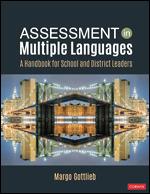Welcome to the Companion Website
Resource 1.1: The Link Between Subgroups of Bi/Multilingual Learners and Assessment
Resource 1.2: Categorizing Terminology: References to Students, Languages, Teachers, and Programs
Resource 2.1: Conducting an Assessment Audit for Multilingual Learners
Resource 2.2: Collecting Language Samples in Multiple Languages as Part of the Enrollment Process
Resource 2.5: Thinking About Assessment as, for, and of Learning
Resource 3.2: Planning Assessment in Multiple Languages for a Unit of Learning
Resource 3.3: A Rating Scale for Planning Common Assessment in Multiple Languages
Resource 3.4: A Checklist for Planning Common Assessment in Multiple Languages
Resource 3:5: Planning Multilingual Portfolios to Represent Assessment as, for, or of Learning
Resource 4.1: Creating a Theory of Action Tool for Assessment in Multiple Languages
Resource 4.2: Using Images in Collecting Common Assessment Data
Resource 4.3: Using Multiliteracies and Multimodal Resources in Assessment as, for, and of Learning
Resource 4.4: A Checklist for Co-planning Data Collection in Multiple Languages
Resource 4.5: Adding Multimodal Communication Channels to Common Assessment
Resource 4.6: Collecting Initial Common Assessment Data (for Students in Grade 3 and Beyond)
Resource 4.7: Assessment Portfolio Considerations
Resource 5.1: Interpreting Classroom, Interim/Common, and Annual Data by Assessment Approach
Resource 5.3: A Checklist of Descriptors for Common Assessment
Resources 5.5: Annotating Multilingual Learners’ Use of Multiple Languages Across Three Dimensions
Resources 6.1: Designing an Equitable Assessment Framework for Multilingual Learners
Resource 6.2: Evaluating Assessment-Capable Classrooms, Schools, and Districts
Resource 6.4: Student-Centered Rubrics
Resource 6.5: Reporting Results From Measures of Assessment of Learning
Resource 6.6: Principles for Grading Multilingual Learners
Resource 7.1: Taking Action Based on Assessment Results in Multiple Languages
Resource 7.2: Determining Priorities in Assessing in Multiple Languages
Resource 7.3: Planning a Student-Led Conference Supported by a Teacher and a Family Member
Resource 7.4: A Learning System Centering on Multilingual Learners
Disclaimer:
This website may contain links to both internal and external websites. All links included were active at the time the website was launched. SAGE does not operate these external websites and does not necessarily endorse the views expressed within them. SAGE cannot take responsibility for the changing content or nature of linked sites, as these sites are outside of our control and subject to change without our knowledge. If you do find an inactive link to an external website, please try to locate that website by using a search engine. SAGE will endeavour to update inactive or broken links when possible.

